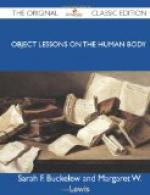Which part do they hurt most?—“The head or brain.”
What harm do they do to the brain?—“They make it unfit to do its work.”
What work does the brain do?—“Thinking.”
Then what harm do rum, brandy, wine, and these other drinks do to the brain?—“They make it unfit to think.”
What other poison do some people use?—“Tobacco.”
When do children use tobacco?—“When they chew tobacco; when they smoke cigars or cigarettes.”
How much does tobacco poison hurt children?—“More than it hurts anybody else.”
In what way does it hurt children?—“It keeps children from growing fast; from being strong and healthy; and from learning as well as they ought.”
How does it do all this mischief to children?—“It poisons their lungs, their heart and blood, and their brain.”
* * * * *
PART II.
Formula for the parts and joints of the body:
1. My limbs are my two arms and my two legs.
2. My arm has two parts:
my upper arm, my fore-arm;
and three joints:
my shoulder joint, my elbow joint, my wrist joint.
3. My hand is used in holding, throwing, catching, and feeling:
the palm of my hand, the back of my hand, my fingers, my thumb, my forefinger, my middle finger, my ring finger, my little finger, my knuckles, my finger joints, my nails, the tips of my fingers, the veins, the ball of my thumb, and the lines where the flesh is bent.
4. My leg has two parts:
my thigh, and my lower leg;
and three joints:
my hip joint, my knee joint, my ankle joint.
5. My foot is used in standing, walking, running, skating, and jumping:
my instep, my toes, the sole of my foot, the ball, the hollow, the heel, my toe joints, and my toe nails, which protect my toes.
* * * * *
Questions for the formula.
1. Which are your limbs?
2. Tell about your arm.
3. Tell about your hand.
4. Tell about your leg.
5. Tell about your foot.
* * * * *
[Illustration: The elbow joint. (A hinge joint.)]
[Illustration: The hip joint. (A ball-and-socket joint.)]
Some joints, as those of the skull, are immovable; some, as those of the spine, may be moved a little; and others more or less freely, as those of the limbs. In machines, the parts which move upon each other need to be oiled, to keep them from wearing out; but the joints of our bodies oil themselves with a thin fluid, called synovia. This fluid resembles the white of an egg, and comes from a smooth lining inside of the joints. The ends of the bones which form joints are covered by gristle or cartilage, and are fastened together by very strong, silvery white bands, called ligaments. A sprain is caused by overstretching or tearing some of these ligaments.




